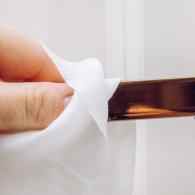According to the Centers for Disease Control and Prevention (CDC), the U.S. has recorded 555 measles cases this year, the second-highest number of measles cases in the U.S. in 25 years. The outbreak is happening across the globe – the World Health Organization reported more than 110,000 measles cases worldwide from January through March, an increase of more than 300% from this period last year.
During times of widespread outbreak, it’s important to keep cleaning and hygiene best practices in mind to prevent measles from impacting your workforce, customers and occupants.
A Highly Contagious Virus
About one of every four people who get measles will be hospitalized. Measles typically start with an elevated fever, cough, runny nose and watery eyes, and then a rash appears three to five days later. Coughing and sneezing allow the virus to spread through the air and onto surfaces, infecting others if they breathe the contaminated air or touch the infected surface. In fact, the measles virus can live for up to two hours on a surface or in an air space.
Limiting the Spread of Measles
Whether you oversee a school, retail store, restaurant, office building or another type of facility, consider these strategies for keeping measles in check:
- Select the right products for disinfection. An effective disinfectant not only helps ensure that surface germs are killed, but that staff can maintain productivity and cover as much ground as possible within their cleaning timeframe. Look for a disinfectant with a shorter dwell time but one that is effective against enveloped viruses like measles. Either a disinfectant spray in a trigger bottle or a disinfectant wipe can be used.
- Order extra essentials. Supplies like disinfectants, soap and paper towels are used more frequently during outbreaks. Never be caught without these items – order extra stock so that your employees always have the solutions they need to clean and everyone in your facility has access to the necessary products for maintaining health.
- Increase the frequency of cleaning. When germs are left unattended on surfaces, they can easily transfer to people’s hands and then to other people. If these individuals touch their eyes, nose or mouth, they can become ill. When the number of cases of a virus like measles spike, increase the frequency of cleaning to ensure your environment doesn’t contribute to its spread. Be sure to clean from top to bottom and to address high-touch surfaces like desks, counters and shopping carts, as well as overlooked areas like sink handles and revolving doors.
- Encourage hand hygiene. Regular hand hygiene can keep those who are ill from further spreading the measles virus and can help healthy people remove potentially infectious germs from their hands. Encourage hand washing by stocking soap and sanitizer, making sure faucets are functioning in restrooms, classrooms and kitchen areas and keeping paper towels easily accessible. Consider installing dispensers that ensure uninterrupted hand hygiene by seamlessly switching from automated to manual mode if batteries stop functioning.
- Promote healthy habits. A major aspect of infection prevention is educating the people who work and frequent your facility about healthy behaviors that curb the spread of illness. Use signage to promote the use of hand sanitizer and hand washing in key areas, distribute communication around the warning signs of measles and encourage individuals to stay home if they feel ill.
Having the right cleaning and hygiene products and procedures in place can help reduce the risk of a measles outbreak in your facility. For more information, visit www.diversey.com/solutions/infection-prevention/outbreak-prevention/measles



